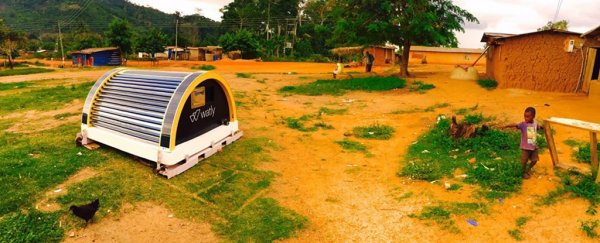For many people living in developing nations, easy access to clean water is an ever-present struggle. It's estimated that 1.2 billion people in the world are living in areas where uncontaminated water is scarce, and the equipment needed for purifying it isn't always available.
So a team led by Italian entrepreneur Marco Attisani has come up with a pretty ingenious solution - a new type of generator that's capable of using solar power to bring clean water, electricity, and even internet access to remote communities anywhere in the world.
It's called Watly, and a prototype is already being tested on a village in Ghana. Its makers have opened up an Indiegogo campaign to fund an even bigger machine - one which would be able to help a community of up to 3,000 people.
Here's how it works: the modular system inside Watly harvests energy through photovoltaic solar panels on its surface, then stores it as electricity in its 140 kWh battery. Some of this power is used to purify and desalinate water from oceans and rivers. It requires low-maintenance to run, and works without a connection to the grid.
For water purification, Watly uses graphene-based technology to separate out soaps, solvents, and hydrocarbons, while a patented system also uses heat from the solar panels to distill the water, before it's put through a special mineraliser and acid reducer to regulate the water's pH level.
Three 5,000-litre tanks store water inside Watly.

That would be valuable enough on its own, but Watly can also recharge phones, lamps, and laptops, bringing electricity to remote communities that can be used for all kinds of purposes.
Internet access can also make a real difference, giving people access to educational materials, health information, current news, and sick science burns.
Watly's makers say it uses a combination of radio links, existing 3G/4G networks, and satellite connections to get online - and separate Watlys can communicate with each other, too. The lifespan of one machine is expected to be around 15 years.
While it's always wise to be wary about fantastical new inventions appearing on crowdfunding sites, Digital Trends reports that Watly has already been through three years of testing and prototyping to get to this stage.
The project has also managed to attract some US$2 million in external investment, and the first Watly trial is going to be featured as part of a Discovery Channel documentary later this year.
For innovation scholar Diran Soumonni from the University of the Witwatersrand in South Africa, who is not involved in the project, the main challenge is not a technical one, but in getting communities to embrace the Watly.
"No matter how cool it is as a technical gadget, unless it gets used it's not considered to be a successful innovation," he told Quartz. "This kind of solution, on the surface of it, is moving in the right direction. What I would like to see is for African inventors who live embedded in these environments or are closer to them to be involved in some co-creation."
